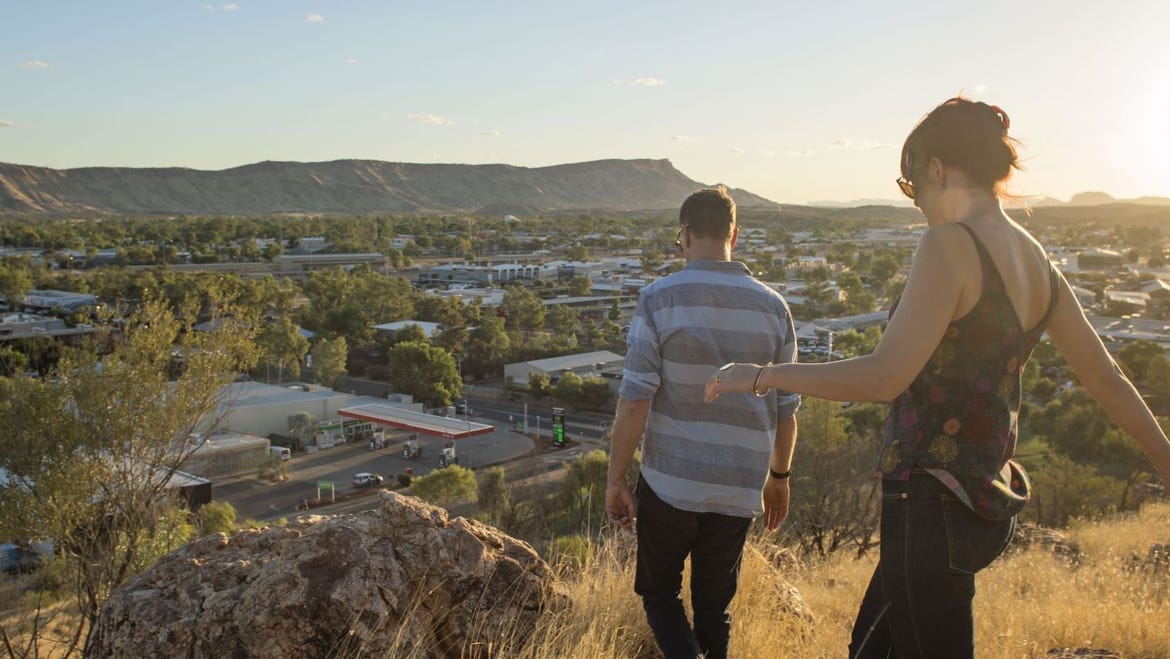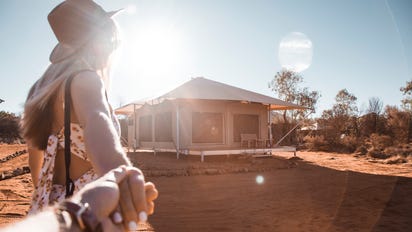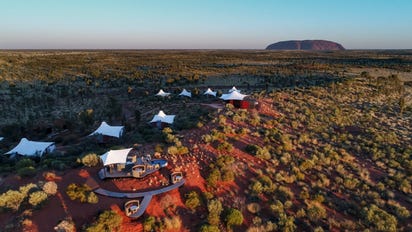If you've got questions about your once-in-a-lifetime adventure in the Territory, we’ve got answers...
How do I get to the NT?
Whether you’re travelling from interstate or overseas, there are a range of ways to get here – by air, road, rail or sea.
Getting to the NT by air
The Territory's main modern well-equipped airport hubs are at Darwin, Alice Springs and Yulara (Ulura) for visitors travelling by air. The NT is serviced by major domestic and international airlines, providing passengers with easy access to destinations across the Territory from almost anywhere in the world.

Getting to the NT by road
Journey by road to the NT on our well-maintained, sealed highways, which provide the most direct routes between the NT and cities in South Australia, Queensland and Western Australia. Once you cross the border into the NT, explore our driving routes around the Territory.
Despite the vast distances, travelling by bus (coach) to the NT is easy and affordable. Major coach and tour companies run coach services between transport hubs in the NT and destinations in Western Australia, South Australia and Queensland.
Getting to the NT by train
The Ghan, one of the world’s great train journeys, is by far the most romantic way to travel to the NT. The Ghan travels an epic 2,797km (1,846 miles) between Adelaide and Darwin, stopping at Alice Springs and Katherine. Watch the change in scenery as you traverse the heart of the country through Central Australia and the outback.
You can also visit Darwin by sea, on a once-in-a-lifetime luxury cruise. With its tropical climate, Darwin enjoys year-round cruise activity.
"Amidst the vast, rugged landscape of the Red Centre, it was the guides and business operators who truly elevated my experience. Their warm hospitality and genuine passion for the land and its culture made me feel not just like a visitor, but a welcomed guest." - Alex, VIC

What’s the best way to get around the NT?
Wherever you want to go in the NT, we’ll find a way to get you there. Travel around the NT by air, road or rail.
Daily flights operate between Darwin, Alice Springs and Uluru. Smaller flights are run between the regional centres by Airnorth.
One of the best ways to discover the NT is by road. 95% of the NT’s attractions are accessible by well-maintained roads. There’s plenty to explore in a 2WD regular car or campervan, as well as in all-terrain 4WDs. Hire companies operate across the NT, so if you fly into the Territory, arrange to collect a vehicle at the airport then hit the road – you could even try one of our driving routes. Local transport options include taxis, airport shuttle, bicycle hire and bus networks.
The Ghan is a unique way to travel around the NT. This epic train journey travels between Adelaide and Darwin, stopping in Alice Springs and Katherine.

Do I need to hire a car in the NT?
Whether you’re planning an off-road adventure or a relaxing campervan holiday, it’s easy to do it yourself and hire a vehicle suited to the NT’s terrain.
Locally run car-hire businesses with expert regional knowledge operate out of Darwin, Alice Springs and other regional centres, as do major national vehicle hire companies such as Britz, Europcar, Hertz and Budget.
Hire companies offer a broad range of vehicles to suit your holiday needs, including automatic and manual cars, 4WDs, campervans, motorhomes and minibuses – some even include camping equipment.
Vehicles can be booked in advance or on arrival, and pick-up from airports, train stations and accommodation can be arranged. Find out more about vehicle hire in the NT.

When’s the best time to visit the NT?
There’s plenty to see and do in the NT all year round. The Territory has two distinct climate zones: the tropical Top End and the semi-arid Red Centre.
The Top Endand the Red Centre each have their own unique climate. In the Top End the climate is tropical. It's summer from November to April with magnificent thunderstorms, spectacular sunsets and warmer weather. There are smaller crowds during summer (which is considered low season), which is a great time to grab hot deals on flights, accommodation and tours.
From May to October is the Dry Season which is warm and pleasant with sunny days and cooler nights.Visit in the Dry to explore all of the attractions in the surrounding national parks and experience the buzz of the sunset markets. Darwin and the Top End are bustling in the dry season, with a packed calendar of events and festivals drawing visitors from near and far to make the most of the balmy outdoor celebrations.

Alice Springs and the Red Centre has 4 typical seasons: summer, autumn, winter and spring. The Red Centre is prone to extremes, with hot summer days (from December to February) and cold winter nights (June to August). Temperatures can drop below freezing overnight in winter and it can get very cold in the desert. Winter is the most popular time to visit as the days are crisp, cool and not too hot.
Spring (September to November) and autumn (March to May) in the Red Centre bring warm days and cool evenings. Read more about the NT’s weather and seasons.

Staying safe in the NT
Safety in any destination depends on various factors. Respect the environment, be aware of wildlife hazards, and stay informed about weather conditions and happenings in the local area. By being mindful of your surroundings and taking necessary precautions, visitors can enjoy exploring the Northern Territory confidently.
Alice Springs has an outback vibe which reflects its Central Australian location. This outback town exudes adventure which attracts outdoor enthusiasts to its natural wonders, Aboriginal culture, and contemporary and traditional art offerings. Alice’s relaxed vibe is part of the attraction which lures visitors from around the world. Behind occasional adverse media headlines, Alice Springs’ vibrant, ancient culture and striking landscapes lure returning visitors to the Red Centre. Contrary media coverage is often not reflected by traveller’s experience according to recent visitors.
“My recent road trip around the Red Centre was absolutely incredible. I felt safe and welcomed throughout the journey. One of the highlights was witnessing the breath taking Uluru sunset and experiencing the Parrtjima festival." Josh, Darwin
While the Northern Territory has remote and rugged areas, it’s essential to take the usual precautions you’d take anywhere. Tourism hubs like Kakadu National Park, Uluru and Litchfield National Park are well regulated with facilities and services to help visitors find their way around safely. Park Rangers, signage boards and online guides increase safety for visitors, including actively monitoring waterways in the Top End for crocodiles. As with any travel experience, exercise common sense, follow guidelines, and you’ll have a safe experience.
"The local tour guide was incredibly welcoming and made the road trip around the Red Centre such a memorable experience. At Kings Canyon we witnessed an unforgettable sunrise and at Karrke Aboriginal Cultural Experience the friendly indigenous tour operators were so happy to share their knowledge and way of life with us." Jirapan, WA
What should I pack for my visit?
As you’ll probably be spending lots of time outdoors experiencing the natural wonders of the NT, be sure to pack casual apparel suitable for the outdoors. Protect yourself against the sun and heat with lightweight clothing, a hat, sunglasses and sunscreen. Comfortable walking shoes are a must, and if you’re visiting the Top End from November to April, you should also bring a light rain jacket. Other essentials include plenty of drinking water, inspect repellent and a camera.
If you plan to visit one of the NT’s many refreshing natural swimming holes – and we strongly recommend you do – bring your swimwear and a towel. If you have them, goggles and an underwater camera might also come in handy. Make sure to only swim where signs indicate it’s safe to do so. Fishing gear is a must for anyone keen on snagging a few barramundi in the Top End, and avid birdwatchers should bring a pair of binoculars.
If you plan to camp between May and September, bring warm clothes as it can get quite cold, particularly in the Red Centre..

The NT is vast, often with long distances between main centres. When driving from one spot to another, ensure you have enough food, water and fuel for the journey. A small first-aid kit can also come in handy.
Most supplies and essentials can be purchased in Darwin, Katherine and Alice Springs.

Top End or Red Centre?
It doesn’t matter whether you’re young or old, keen for adventure or looking to relax, on a budget or ready to splurge, a holiday in the NT is an experience like no other. Whether you visit the Top End, Red Centre, or are lucky enough to travel to both, there are countless one-of-a-kind encounters to be had in the NT.
The Top End offers both a cosmopolitan and outback holiday experience with iconic national parks, waterfalls, ancient culture, unique wildlife and exceptional local dining. There are 4 distinct regions in the Top End – Darwin, Kakadu, Katherine and Arnhem Land – and each has plenty to offer.
The Red Centre is a region full of natural wonders, including Uluru, Kings Canyon and Kata Tjuta (The Olgas). Alice Springs epitomises the Australian outback character and is your basecamp for adventure, with waterholes, biking and hiking trails, historic and wildlife centres and four-wheel driving all within easy access.
“The Red Centre is a truly special part of Australia which shouldn't be missed! Not only are the landscapes something that everyone should experience, the rich indigenous culture captivates, such as Karrke Aboriginal Cultural Experience. The local indigenous guides are warm, welcoming and excited to teach you all about their culture. Everyone you meet is excited to share this incredible part of Australia”Lola, WA

How much time do I need?
Although the NT is vast – 6 times the size of Britain – you can discover many of its most popular destinations in as little as 3 days, including Darwin, Alice Springs or Uluru. To explore a full region, or the whole of the NT, we recommend 7 to 14 days.
Choose from one of our example itineraries or tailor your own journey.

What about crocodiles?
Saltwater crocodiles, the most famous of the NT’s creatures, can be seen in rivers and billabongs in the Top End or at wildlife parks around the NT.
Any body of water in the Top End may contain large and potentially dangerous crocodiles. Saltwater crocodiles can be found in both fresh and salt water. Saltwater crocodiles are dangerous – you should never take unnecessary risks in a crocodile habitat.
When it comes to crocodiles, the Northern Territory Government takes your safety seriously, but ultimately how you behave around crocodile habitats is your responsibility.

Always observe crocodile safety signs and assume that they are present, even if you can’t see them. With almost as many crocodiles as people in the north, you’re sure to come across them in Territory waterways.
There are approximately 150,000 saltwater crocodiles and at least 100,000 freshwater crocodiles across northern Australia.
Find out more about how to be safe around crocodiles.

Where can I find out more information about travelling in the NT?
Find out about places to go and things to do in the NT, planning information for your trip and travel ideas including articles, itineraries and driving routes on northernterritory.com.
The Tourism Top End and Tourism Central Australia websites also contain useful information for planning your NT travels. Or contact one of the NT’s Visitor Information Centres.
Where are the accredited Visitor Information Centres located in the NT?
The NT’s 4 main Visitor Information Centres are located in Darwin, Katherine, Alice Springs and Tennant Creek. Local tourist information counters can also be found at major transport hubs and attractions.
The centres are staffed with knowledgeable, helpful locals who can help with advice and information, and make tour and accommodation bookings on your behalf. All centres are stocked with handy maps, and brochures covering just about anything you could want to do or see in the NT.

Do I need to book accommodation & tours before I arrive?
It’s not essential to book accommodation and tours before you arrive in the NT, however we recommend you book your accommodation in advance to avoid disappointment – especially during the peak periods (May to September). It’s generally possible to book accommodation and tours when you arrive at most NT destinations.
Share this
繼續探索
更多您可能喜歡的文章



